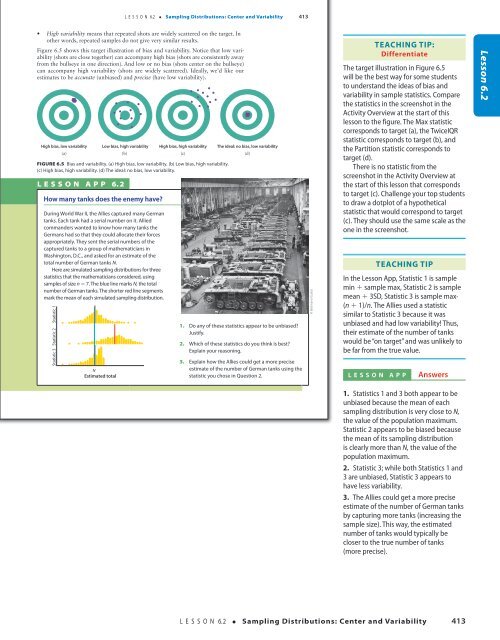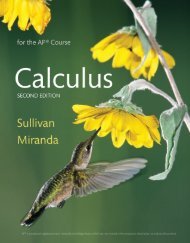SPA 3e_ Teachers Edition _ Ch 6
Create successful ePaper yourself
Turn your PDF publications into a flip-book with our unique Google optimized e-Paper software.
L E S S O N 6.2 • Sampling Distributions: Center and Variability 413<br />
• High variability means that repeated shots are widely scattered on the target. In<br />
other words, repeated samples do not give very similar results.<br />
Figure 6.5 shows this target illustration of bias and variability. Notice that low variability<br />
(shots are close together) can accompany high bias (shots are consistently away<br />
from the bullseye in one direction). And low or no bias (shots center on the bullseye)<br />
can accompany high variability (shots are widely scattered). Ideally, we’d like our<br />
estimates to be accurate (unbiased) and precise (have low variability).<br />
d<br />
ddd dd dd<br />
High bias, low variability<br />
(a)<br />
d<br />
d<br />
d<br />
d d<br />
Low bias, high variability<br />
(b)<br />
d<br />
d<br />
d<br />
d<br />
d<br />
d<br />
High bias, high variability<br />
(c)<br />
d<br />
d<br />
d<br />
d<br />
d<br />
d<br />
d<br />
d<br />
d<br />
d<br />
d<br />
d<br />
FigUre 6.5 Bias and variability. (a) High bias, low variability. (b) Low bias, high variability.<br />
(c) High bias, high variability. (d) The ideal: no bias, low variability.<br />
L e SSon APP 6. 2<br />
How many tanks does the enemy have?<br />
During World War II, the Allies captured many german<br />
tanks. Each tank had a serial number on it. Allied<br />
commanders wanted to know how many tanks the<br />
germans had so that they could allocate their forces<br />
appropriately. They sent the serial numbers of the<br />
captured tanks to a group of mathematicians in<br />
Washington, D.C., and asked for an estimate of the<br />
total number of german tanks N.<br />
Here are simulated sampling distributions for three<br />
statistics that the mathematicians considered, using<br />
samples of size n 5 7. The blue line marks N, the total<br />
number of german tanks. The shorter red line segments<br />
mark the mean of each simulated sampling distribution.<br />
Statistic 3 Statistic 2 Statistic 1<br />
d<br />
d<br />
d<br />
d<br />
d<br />
d dd<br />
d<br />
d<br />
dd<br />
d<br />
d ddd<br />
dd ddd d<br />
dd dd d d<br />
d<br />
d<br />
ddd<br />
d d<br />
d d d<br />
dd d<br />
ddd<br />
dd<br />
d dddddd d<br />
ddd<br />
d<br />
d<br />
dd<br />
d d<br />
ddd ddd d<br />
d<br />
d<br />
d<br />
N<br />
Estimated total<br />
dd d<br />
ddd<br />
The ideal: no bias, low variability<br />
(d)<br />
1. Do any of these statistics appear to be unbiased?<br />
Justify.<br />
2. Which of these statistics do you think is best?<br />
Explain your reasoning.<br />
3. Explain how the Allies could get a more precise<br />
estimate of the number of german tanks using the<br />
statistic you chose in Question 2.<br />
© Bettmann/Corbis<br />
Teaching Tip:<br />
Differentiate<br />
The target illustration in Figure 6.5<br />
will be the best way for some students<br />
to understand the ideas of bias and<br />
variability in sample statistics. Compare<br />
the statistics in the screenshot in the<br />
Activity Overview at the start of this<br />
lesson to the figure. The Max statistic<br />
corresponds to target (a), the TwiceIQR<br />
statistic corresponds to target (b), and<br />
the Partition statistic corresponds to<br />
target (d).<br />
There is no statistic from the<br />
screenshot in the Activity Overview at<br />
the start of this lesson that corresponds<br />
to target (c). <strong>Ch</strong>allenge your top students<br />
to draw a dotplot of a hypothetical<br />
statistic that would correspond to target<br />
(c). They should use the same scale as the<br />
one in the screenshot.<br />
Teaching Tip<br />
In the Lesson App, Statistic 1 is sample<br />
min 1 sample max, Statistic 2 is sample<br />
mean 1 3SD, Statistic 3 is sample max·<br />
(n 1 1)/n. The Allies used a statistic<br />
similar to Statistic 3 because it was<br />
unbiased and had low variability! Thus,<br />
their estimate of the number of tanks<br />
would be “on target” and was unlikely to<br />
be far from the true value.<br />
Lesson App<br />
Answers<br />
Lesson 6.2<br />
18/08/16 5:00 PMStarnes_<strong>3e</strong>_CH06_398-449_Final.indd 413<br />
18/08/16 5:00 PM<br />
1. Statistics 1 and 3 both appear to be<br />
unbiased because the mean of each<br />
sampling distribution is very close to N,<br />
the value of the population maximum.<br />
Statistic 2 appears to be biased because<br />
the mean of its sampling distribution<br />
is clearly more than N, the value of the<br />
population maximum.<br />
2. Statistic 3; while both Statistics 1 and<br />
3 are unbiased, Statistic 3 appears to<br />
have less variability.<br />
3. The Allies could get a more precise<br />
estimate of the number of German tanks<br />
by capturing more tanks (increasing the<br />
sample size). This way, the estimated<br />
number of tanks would typically be<br />
closer to the true number of tanks<br />
(more precise).<br />
L E S S O N 6.2 • Sampling Distributions: Center and Variability 413<br />
Starnes_<strong>3e</strong>_ATE_CH06_398-449_v3.indd 413<br />
11/01/17 3:54 PM




